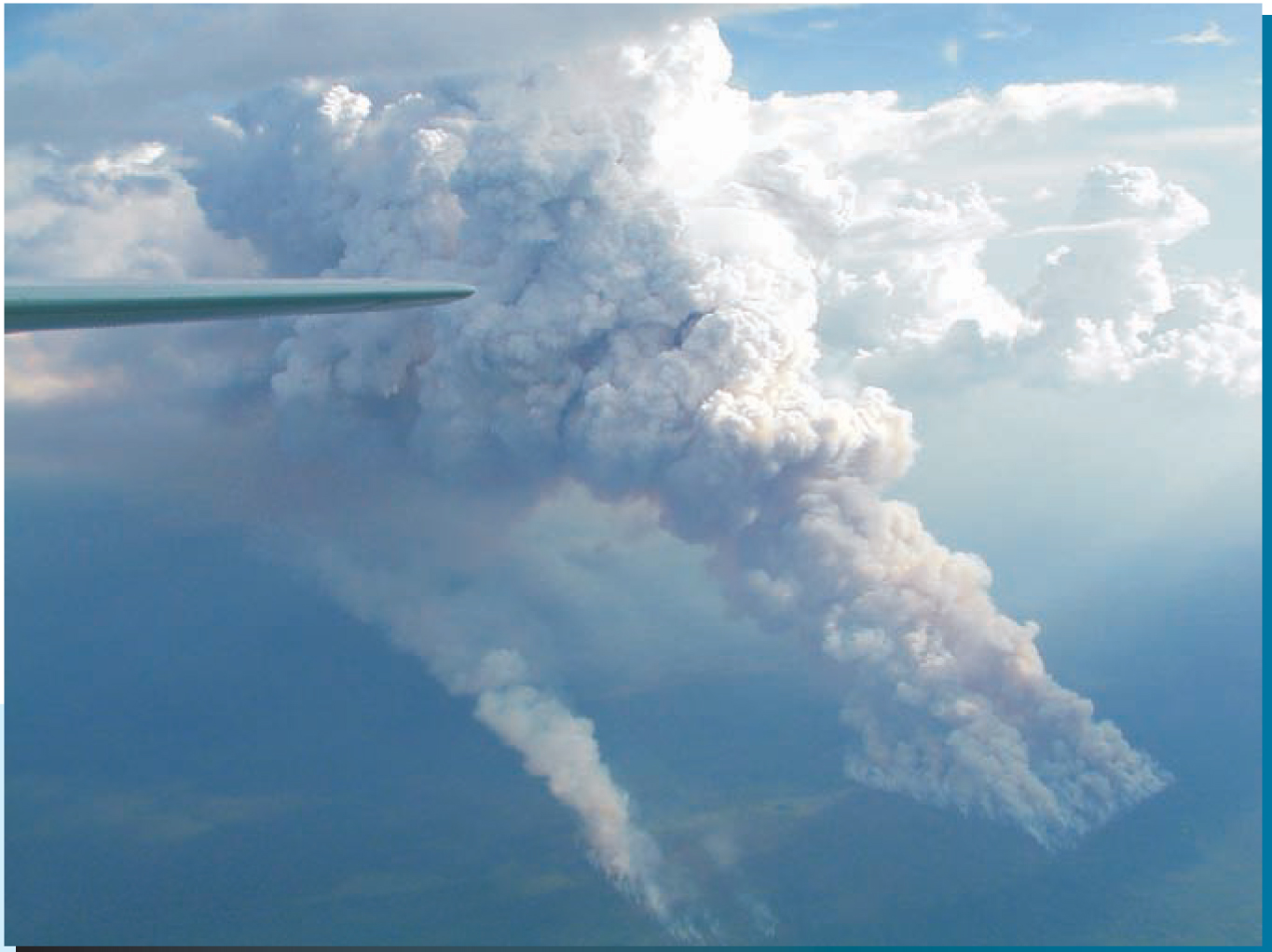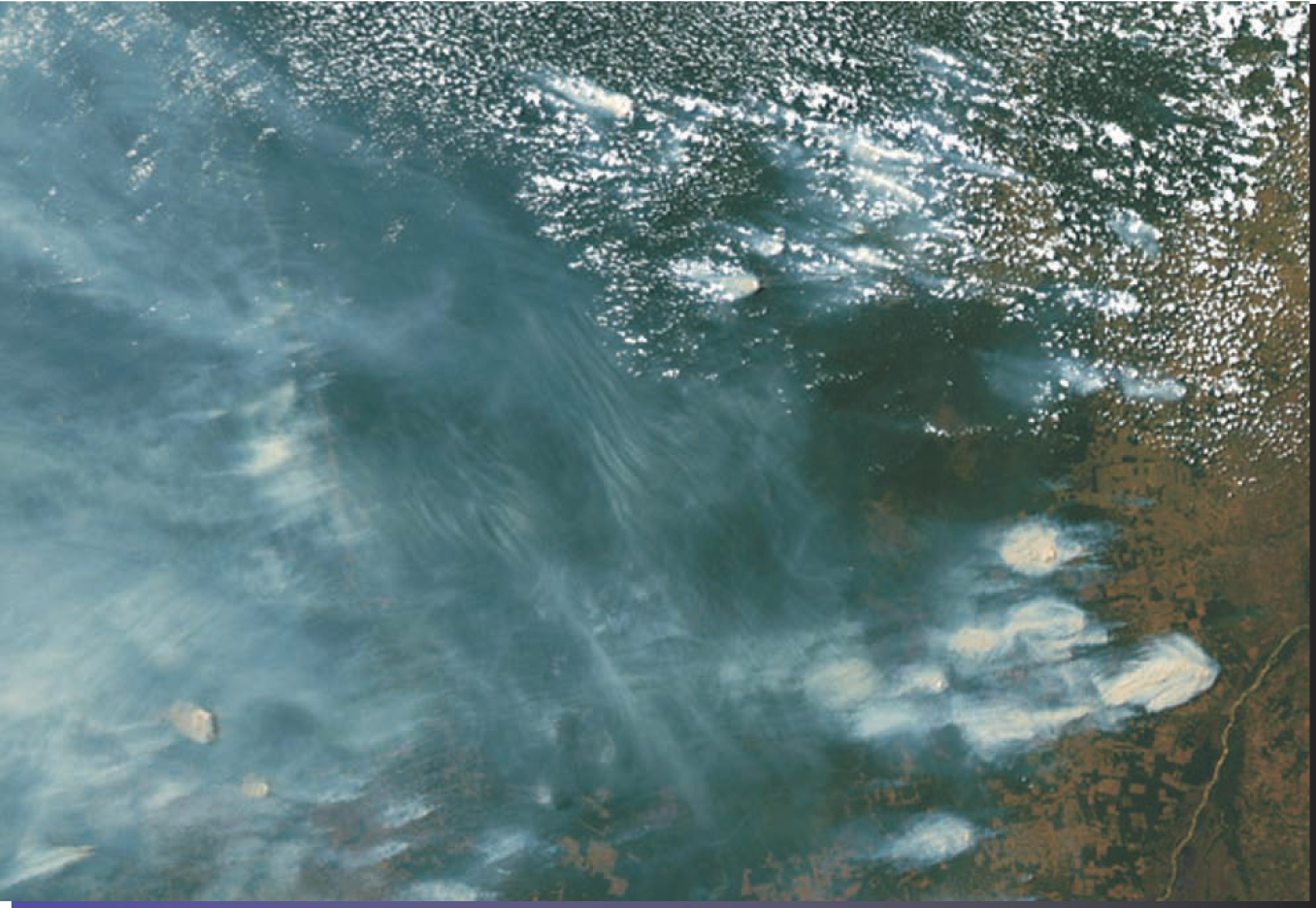Smoke From Burning Vegetation Changes the Coverage and Behavior of Clouds
DOI: 10.1063/1.1768664
In the Amazon Basin, at the beginning of each dry season in May, farmers start felling trees and clearing undergrowth. The damp vegetation dries out on the ground for a few months. Then, before the rains resume, the farmers set the vegetation on fire. Most of the burning occurs on vast estates. Areas kilometers across are cleared to make way for agriculture. Figure 1 shows one example from the state of Rondonia in western Brazil.

Figure 1. Biomass burning in Rondonia, Brazil, and elsewhere sends smoke into the atmosphere, where it affects the properties and dynamics of clouds.
(Courtesy of Bernd Willing, Max Planck Institute for Chemistry.)

The clearances change more than what grows on the ground. Like other aerosols, smoke particles intercept solar radiation and increase the reflectivity of clouds. Both effects tend to cool Earth’s surface. However, like much in climate science, the overall impact of aerosols is complicated by feedbacks. For example, by cooling the surface, aerosols slow surface winds, thereby reducing the uptake of aerosols such as dust, sea spray, and pollen. Ignorance of aerosol effects is among the biggest obstacles to understanding Earth’s current and future climate.
Two recent studies examine how smoke from biomass burning affects clouds and climate in the Amazon Basin. In one study, Ilan Koren and his colleagues from NASA’s Goddard Space Flight Center in Greenbelt, Maryland, confirm a seven-year-old idea that sooty aerosols can reduce climate-cooling cloudiness. 1 In the other study, an international team led by Meinrat Andreae of the Max Planck Institute for Chemistry in Mainz, Germany, finds that smoke drastically modifies its own vertical transport through clouds. 2
Fewer clouds
Last year, Koren set out to investigate the effect of smoke on clouds using data from NASA’s Terra and Aqua satellites. To be sure of isolating the effect of smoke, he sought clouds that spanned smoky and smoke-free areas. At first, he couldn’t find any: Clouds and heavy smoke didn’t coincide.
That was puzzling. Clouds can’t form without aerosols, which nucleate water droplets. When smoke particles add to the concentration of natural aerosols, the available water is spread among a larger number of smaller droplets. Because small droplets don’t form rain drops as easily as large droplets, the clouds last longer. This effect, first noticed by Sean Twomey in the 1970s, has been observed downwind of factory smokestacks.
Other processes could be at work. In 1997, James Hansen of NASA’s Goddard Institute for Space Studies in New York City noted that sooty aerosols, by absorbing solar radiation and reradiating it at longer wavelengths, cool Earth’s surface and warm the atmosphere. The cooler surface reduces evaporation; the warmer atmosphere hinders condensation; and the flatter temperature gradient damps convection. The result: Less water is drawn into the atmosphere to form fewer clouds. 3 Hansen termed the effect “semi-direct.”
Hansen’s prediction, which occupied a paragraph in a 33-page paper about climate simulation, wasn’t in the mind of V. “Ram” Ramanathan of the Scripps Institution of Oceanography when, in early 1998, he looked for aerosol-cloud interactions over the Indian Ocean. At that time of year, known as the dry monsoon, steady northerly winds sweep India’s pollution out over the ocean. Expecting to see clouds, he saw mostly smoke.
Working with Ramanathan, Andrew Ackerman of NASA’s Ames Research Center in Moffett Field, California, ran a detailed cloud simulation. 4 Instead of making the clouds more reflective, the smoke in Ackerman’s model burned off the clouds, consistent with Hansen’s idea. Unfortunately, the air over the Indian Ocean was so dry that there were too few clouds to check the model’s predictions.
The Amazon Basin turns out to be ideal for studying the effect of smoke on clouds. Most mornings during the dry season, winds from the Atlantic Ocean bring in moisture. As the sun rises and warms the surface, small cumulus clouds begin to grow. By early afternoon, when Aqua flies overhead, the clouds have matured.
The MODIS instrument on board Aqua images Earth in seven spectral bands from blue to near IR. Clouds and smoke have different spectral signatures. By comparing covered and uncovered areas in the seven images, one can deduce both the cloud cover and the aerosol optical depth. A MODIS image appears in figure 2.

Figure 2. Cloud formation in smoke-filled air over the Amazon Basin as seen by the MODIS instrument on NASA’s Aqua satellite.

Realizing that he might be able to confirm the semi-direct effect, Koren undertook a systematic study. He and his coworkers identified areas that experienced the same meteorological conditions. Then, they quantified cloud fraction and plotted it against aerosol optical depth. As he had noticed before, smoke-free areas were cloudy, while very smoky areas were cloud free. But the analysis also revealed that areas of intermediate smokiness had intermediate cloudiness. Cloud fraction was a smooth, monotonic function of aerosol optical depth.
To gauge the impact of the semi-direct effect on climate, Koren calculated the radiance at the top of the atmosphere as a function of smoke optical depth. In the absence of the semi-direct effect, Koren estimated that the smoke contributes about 12 W/m2 of regional cooling during the Amazon dry season. Incorporating the semi-direct effect cuts the cooling in half.
In the 1960s, when Earth’s climate appeared to cool, some climate scientists believed that anthropogenic aerosols might be offsetting the warming caused by greenhouse gases. But the warming trend continued—perhaps, speculate Koren and his colleagues, because of the semi-direct effect. Clinching that case will require global climate models that better represent the complexity of aerosol radiative effects and cloud feedbacks.
Hotter clouds
During the Amazonian dry season of 2002, Andreae led a campaign to fly two instrument-packed planes through clean and smoky clouds. The goal: to directly measure aerosols and their effects.
To determine aerosol concentration, Andreae and his colleagues drew air into a chamber on one of the planes. Saturating the trapped air with butanol vapor caused the aerosol particles to nucleate large droplets, which were sent one by one through an optical particle counter. Not all aerosols can nucleate water. To count the ones that do, the team used a similar instrument, but one filled with water vapor.
Andreae’s colleague, Danny Rosenfeld of the Hebrew University of Jerusalem, oversaw the measurement of cloud properties. The second plane, equipped with wing-mounted lasers, fired pulsed beams into the clouds ahead. A set of imagers measured the light scattered by the droplets.
Spacecraft view the top few meters of a cloud. But by flying through clouds at a series of different altitudes, Andreae and his team could build up a vertical picture of what happens in the clouds that form despite the smoke.
As expected, the smoke raises the concentration of small droplets that don’t precipitate. Deprived of rain’s cooling effect, updrafts become stronger and push the droplets higher than they would otherwise reach in clean air. Eventually, the droplets supercool, freeze, then release their latent heat into the upper atmosphere. Thus energized, the clouds rain hail on the land below.
Updrafts are strongest for what Andreae termed “pyro-clouds,” one of which appears in figure 1. In these clouds, the upwelling air carries water and smoke high into the atmosphere where they disperse. What happens to the water and smoke isn’t clear. But Andreae believes their effect on regional and global circulation is likely to be substantial.
References
1. I. Koren et al., Science 303, 1342 (2004).https://doi.org/10.1126/science.1089424
2. M. O. Andreae et al., Science 303, 1337 (2004).https://doi.org/10.1126/science.1092779
3. J. Hansen, M. Sato, R. Ruedy, J. Geophys. Res. 102, 6831 (1997).https://doi.org/10.1029/96JD03436
4. A. S. Ackerman et al., Science 288, 1042 (2000).https://doi.org/10.1126/science.288.5468.1042
